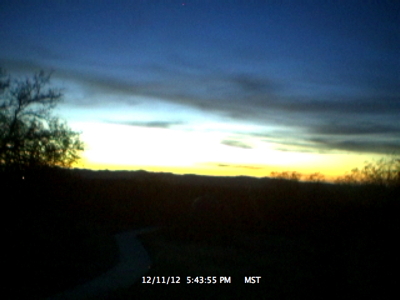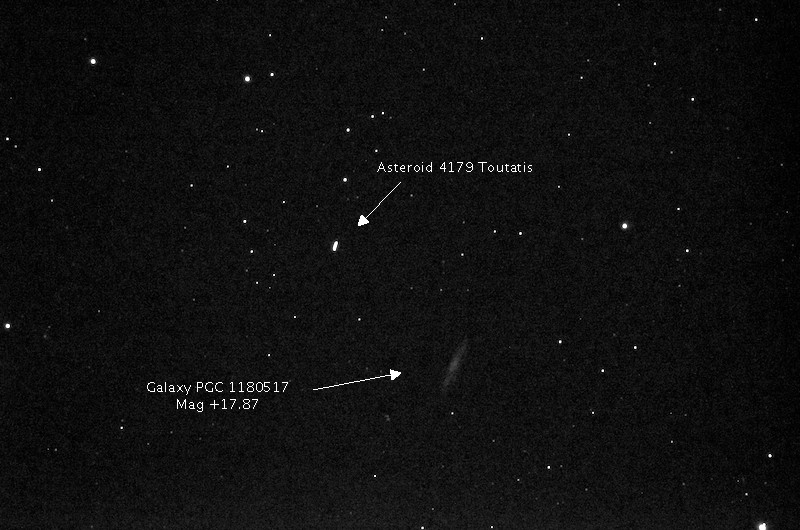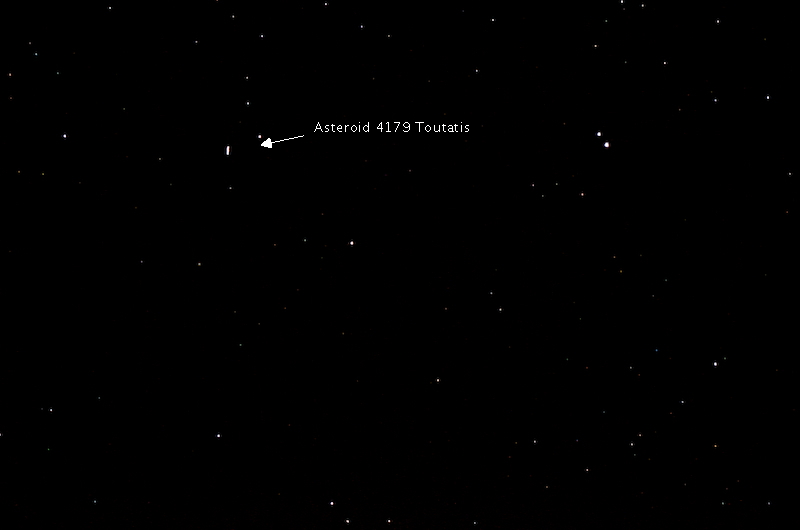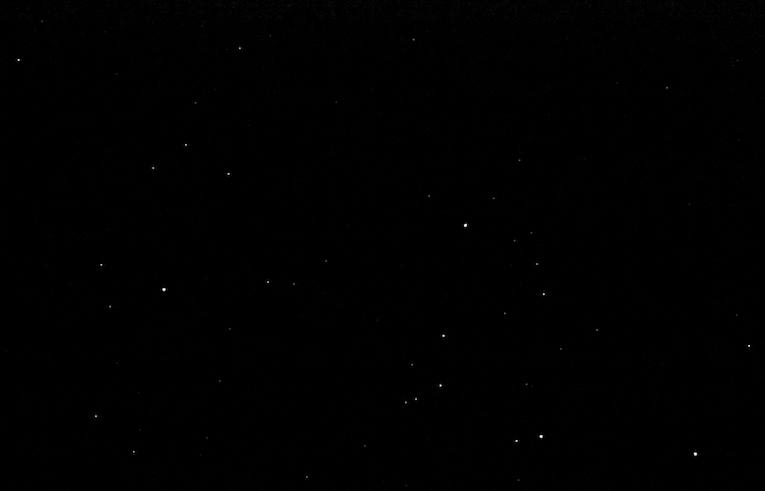
Observing & Imaging Asteroid 4179 Toutatis Close Approach
Posted: 12 December 2012
Tuesday, 11 December 2012, had some clouds come in during the daytime. They were still around after sunset, as seen by my Live Webcam:

I had planned to image the International Space Station as it made an excellent pass about 50 minutes after sunset. Unfortunately, I got home too late from a meeting, so I missed it. But even with clouds threatening, I wanted to observe and image the close approach of Asteroid 4179 Toutatis this night, so I opened the observatory at 1904 MST, 50°F. The sky was partly cloudy. At 1910 MST, viewed Jupiter, 77X. Four moons were visible.
I began my search for Asteroid 4179 Toutatis at 1918 MST using 77X. I slewed to the RA/Dec as reported by SkySafari 3 Pro on my iPhone. At 1940 MST, motion in the field-of-view was suspected. I switched to 222X to confirm it. It was challenging to initially detect and then confirm the asteroid due to clouds and there being no bright stars near its current position. I switched back to 77X and at 1948 MST, I was confident I had properly IDed the asteroid. Closest approach would not occur for about 4 hours (at 2340 MST). I began preparing the D7000 DSLR for prime focus imaging with the 8" LX200-ACF. The clouds were decreasing by this time. At 2005 MST, the asteroid was nearing the central meridian and a few minutes later I decided I would start imaging since the asteroid would be low in the sky at closest approach to the Earth.
I did a focus test image with the Bahtinov Mask on the star Fomalhaut, then locked the telescope focus. At 2028 MST, I began imaging of the asteroid by doing a framing test exposure. I found a guide star and did some 1 minute, ISO 1600, guided exposures. I then discovered that the focus had shifted. (Problem #1.) I redid the focus test image using Alpha Cetus and relocked the focus. I then did another framing test image, followed by some guided exposures using the same guide star as I initially used. Unfortunately, that put the asteroid near the edge of the image FOV. I tried for better framing and did some test exposures. I then had my first ever runaway slewing with the LX200-ACF. The Wireless AutoStar II handcontroller even locked up. (Problem #2.) I cycled the power on the handcontroller several times without re-establishing control over the telescope, which was continuing to slowly slew. I was getting worried that I would have to power off the telescope, which would mean that I would have to re-do the star alignment, which would result in a further delay in asteroid imaging. Eventually, I did get control back without needing to power off the telescope. Whew! Of course, the asteroid's rapid motion meant that it was now a long ways from where I had been imaging.
At 2114 MST, having recovered from the problems, I resumed imaging of Asteroid 4179 Toutatis. This is a 1 minute, ISO 1600, guided (on a star), exposure:

A faint (Magnitude +17.87) galaxy was also captured in this short, low ISO, exposure.
Compare the trailing of the asteroid on 11 December (above) with the trailing the night before (10 December), below:

The length of the trail appears to be just slightly longer on the night of closest approach.
I then did a series of 10 second, ISO 3200, unguided exposures at one minute intervals. This animated GIF shows the motion of Asteroid 4179 Toutatis:

I ended imaging at 2132 MST and resumed observing the asteroid with 77X and 222X. At 2225 MST, using 222X, the movement of the asteroid as it passed bright stars was clearly obvious in just a few seconds. I continued watching the asteroid up through the time of its closest approach (2340 MST).
While monitoring the asteroid, I would occasionally watch the sky for Geminid meteors. I saw several Geminids and some non-Geminid meteors. Two non-Geminids were in the southern sky, moving north to south. They might have been from a newly discovered meteor shower. At 2259 MST, a bright Geminid meteor appeared in the southern sky and it exploded. Nice!
The asteroid was low in the sky from my location at closest approach. I ended this nice session shortly afterwards.
Closed the observatory at 2352 MST, 43°F.
Comments are welcome; use the Comments section below, or you can Email Me. Thanks.
Go to the previous report.
Return to the Cassiopeia Observatory Home Page.